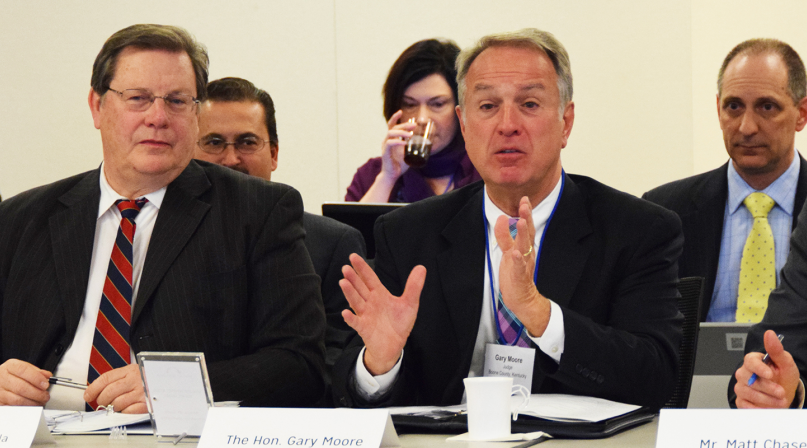Joint opioid task force takes first steps
Author
Upcoming Events
Related News

Boone County, Ky. Judge Gary Moore, co-chair of the National City-County Task Force on the Opioid Epidemic, makes opening remarks at the task force’s inaugural meeting. Seated next to Moore is fellow co-chair, Little Rock, Ark. Mayor Mark Stodola. Photo by Alix KashdanLocal governments unite to fight opioid abuse
A toolkit for counties, a social media strategy, one voice with one message on the national level — these are a few of the hoped-for outcomes from members of the National City-County Task Force on Opioid Abuse that met for the first time April 7 in Washington, D.C.
The 24 task force members led by co-chairs Judge Gary Moore, Boone County, Ky., and Mayor Mark Stodola, Little Rock, Ark., engaged in daylong discussions about prevention campaigns, treatment options and public safety challenges.
A joint effort by NACo and the National League of Cities (NLC), the task force was formed to foster collaboration and ramp up local leadership in the fight against prescription drug abuse and heroin use.
There are 11 deaths per week from drug overdoses in Erie County, N.Y. — more than enough to move Erie County Executive Mark Poloncarz to issue an emergency executive order in January, in part to draw attention to the overdose outbreak and in part to mobilize the county’s resources to tackle the escalating loss of life.
Poloncarz’s story was one of many anecdotes from city and county leaders grappling with the opioid epidemic in their communities.
On their agenda were three discussion topics: prevention and education; treatment; and public safety and community well being.
To set the stage, members were first presented with a big data picture on the growth of the heroin epidemic, a trail of despair and death that has moved out from an urban core into the nation’s suburbs and rural areas, killing more people in 2014 than automobile accidents. Drug overdose was the leading cause of accidental death in the U.S., with 47,055 lethal drug overdoses in 2014, according to the American Society of Addiction Medicine
The mapped review of the spread of heroin and pain prescription abuse, by Chris Reith from Socrata, a cloud software company focused on digital government, sparked discussion about the accuracy of the data
used to illustrate the locations and penetration of prescription drug and heroin abuse. “Some communities underreport their overdoses,” said Manchester, N.H. Police Chief Nick Willard, afraid that accurate reporting would reflect poorly on their cities and counties and make them less attractive places for business.
Even with possible underreported data, the maps Socrata had prepared (based on CDC data) showed the dramatic spread of abuse over the last decade and a half. A CDC report has stated, “Since 2000, the rate of deaths from drug overdoses has increased 137 percent, including a 200 percent increase in the rate of overdose deaths involving opioids (opioid pain relievers and heroin).”
Following the data review, prevention and treatment discussions dominated the day.
Robert Morrison, executive director, National Association of State Alcohol and Drug Abuse Directors (NASADAD), led the discussion on prevention and education. In Morrison’s opening remarks, he said NASADAD is working “to elevate prevention as a core part of our strategy to combat the opioid epidemic.”
A wide-ranging discussion followed that touched on the importance of coalitions, funding for coalitions, observations that too much of federal support for local prevention efforts is taken by states for administrative costs, the importance of having a “youth track” in all prevention efforts, the impact stigma can have in blocking prevention efforts and back again to the importance of educating children and youth on the dangers of drug abuse.
Morrison urged task force members to take control of their communities and “not let drug overdoses become the norm.” He also urged them to institute an addiction initiative “because in five to 10 years, there will be another epidemic.”
HELP FROM THE FEDS
- Several executive branch agencies have announced initiatives to attack various facets of opioid and heroin abuse. Learn more.
Addiction treatment was next on the agenda, focused primarily on medication-assisted methods such as methadone and Suboxone.
Treatment professionals have a nearly a 50-year history with methadone and a shorter time, 10 years, with Suboxone, but enough in both cases to know that mortality rates from all causes are reduced in half and the risk of HIV infection is also halved, said Melinda Campopiano, medical officer at the Substance Abuse Mental Health Services Administration (SAMHSA), who led the discussion.
The presentation prompted a lively discussion about stressed capacity
“In Multnomah County, there are way more people seeking treatment than slots available,” Multnomah County Commissioner Judy Shiprack said. Judge Moore said the methadone clinic in his county sees 1,000 to 1,100 people a day, and the community is beginning to push back, afraid that centralizing treatment will increase crime rates in the area.
Anne Arundel County, Md. Executive Steve Schuh offered three impediments to mounting treatment programs and “community resistance” was number one.
Ross County, Ohio Commissioner Doug Corcoran added another dimension to the problem of more demand than available slots. Inadequate capacity at one end means more people in jails, and more people in jail means more cost for counties as they pick up the tab for treatment, Ross said.
The final discussion took its color from the streets of Manchester, N.H., as Police Chief Nick Willard, who led the Public Safety and Community Wellness discussion along with Kern County, Calif. Supervisor Leticia Perez, described his department’s efforts to stem the drug traffic in his city and the philosophy that guides it.
“Addressing opioid abuse is not just getting the bad guys off the street, but it’s providing social interventions as well,” he said. Willard also talked about his department’s child advocacy program that “circles back with services after a SWAT raid,” its recovery coaches and the importance of having peer-to-peer programs for children and youth in any prevention efforts.
Yet, getting the “bad guy” off the street was clearly an important objective as illustrated by Willard’s recitation of a long list of arrest and drug seizures numbers. In the end though, “despite law enforcement’s best efforts, we’re not winning.”
Help from the Feds
Several executive branch agencies have announced initiatives to attack various facets of opioid and heroin abuse, many of which will reach the county level. These were announced at the National Rx Drug Abuse and Heroin Summit in Atlanta in March
Justice
- The Office of National Drug Control and Policy is adding Ohio and Michigan to the existing High Intensity Drug Trafficking Areas, a designation which supports local law enforcement agencies, including sheriffs’ offices, to reduce drug trafficking.
- The Department of Justice’s COPS Anti-Heroin Task Force Program is distributing $7 million to local law enforcement agencies to investigate distribution of heroin, unlawful distribution of prescription opioids and unlawful heroin and prescription opioid traffickers. This money will go to states with high rates of treatment admissions for heroin and opioid abuse.
Treatment
- The Department of Health and Human Services is expanding access to buprenorphine, a drug used to treat opioid addiction. HHS’s proposed rule increases the patient limit per physician, currently 100, to 200.
- The Substance Abuse and Mental Health Services Administration is funding $11 million to up to 11 states to expand their medication-assisted treatment services.
- HHS is requiring that Medicaid and the Children’s Health Insurance Program offer mental health and substance abuse services be offered at parity — comparable to medical and surgical benefits.
- HHS is issuing guidance for the use of federal funds in maintaining syringe services to reduce the spread of diseases through needle sharing.
Attachments
Related News

U.S. House reintroduces legislation to address the Medicaid Inmate Exclusion Policy
Two bipartisan bills aimed at addressing the Medicaid Inmate Exclusion Policy (MIEP) were recently reintroduced in the U.S. House of Representatives.

House E&C Committee advances SUPPORT Act reauthorization
On April 9, the U.S. House Energy and Commerce Committee marked up the SUPPORT for Patients and Communities Reauthorization Act of 2025. The bipartisan bill aims to reauthorize critical programs that target overdose prevention amid the renewal of the opioid crisis Public Health Emergency declaration.

Bird flu update: What county leaders should know
As of April 7, there have been 70 confirmed cases of bird flu in the United States, but no person-to-person spread has been detected.
